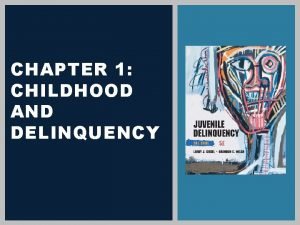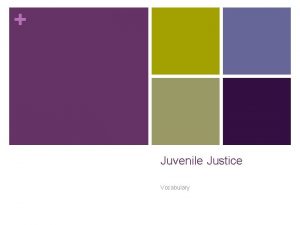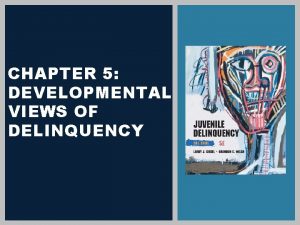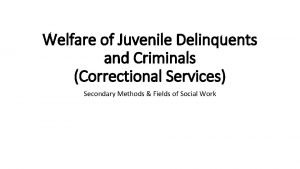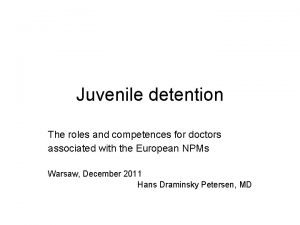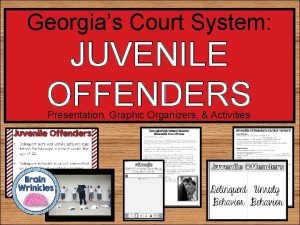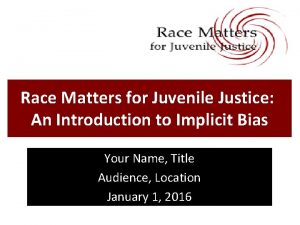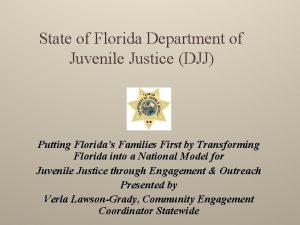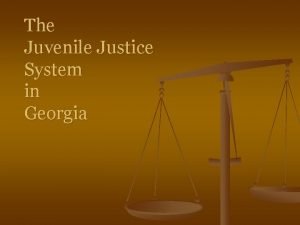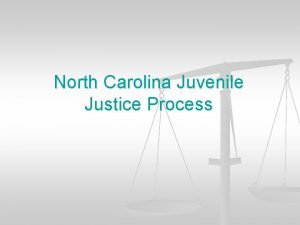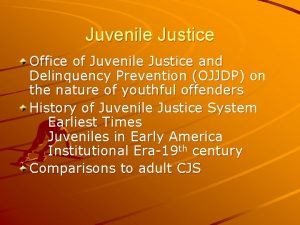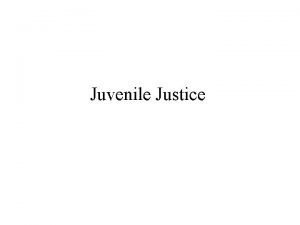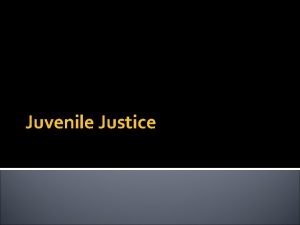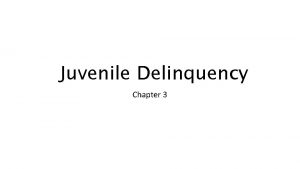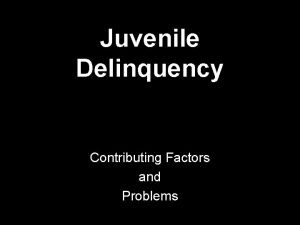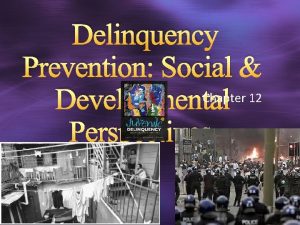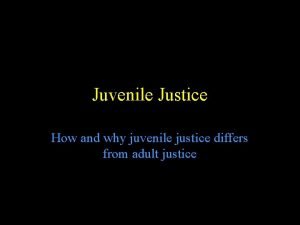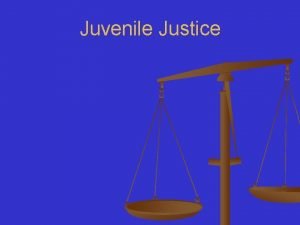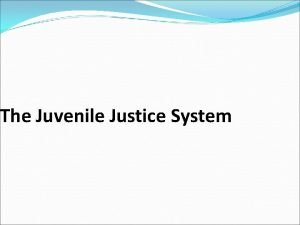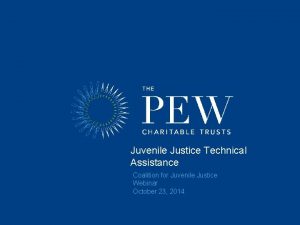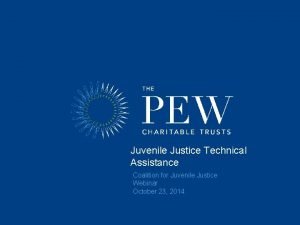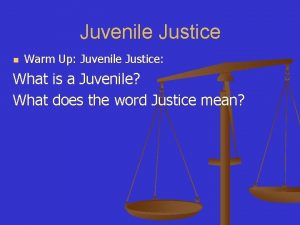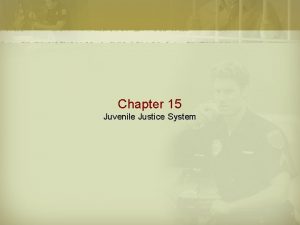2015 Legislative Conference Juvenile Justice and Delinquency Prevention





















- Slides: 21

2015 Legislative Conference Juvenile Justice and Delinquency Prevention Carmen Daugherty Policy Director Campaign for Youth Justice Naomi Smoot Senior Policy Associate Coalition for Juvenile Justice

Agenda 1. PTA & Juvenile Justice a. History and Position Statement 2. Juvenile Justice and Delinquency Prevention Act (JJDPA) a. Overview b. Core Protections c. JJDPA Reauthorization-Recommendations to Congress 3. Juvenile Justice Updates a. On the Hill b. In the Courts c. In the States 4. Q&A

PTA & Juvenile Justice: History • 1899: PTA convention delegates pass first juvenile justice-related resolution supporting the extension of juvenile courts and probation systems to prevent children from being incarcerated with adults • 1903: PTA establishes Committee on Juvenile Protection • 1950 s-1960 s: PTA mobilizes members to advocate for policies that place less emphasis on incarceration, calling instead for increased supportive services and protection of all children

PTA’s Position Statement on Juvenile Justice • • Promote initiatives to address racial, ethnic, and socioeconomic inequities in the juvenile justice system. Encourage collaboration between law enforcement, the judicial system, and child welfare agencies. Promote alternative dispute resolution techniques that provide a range of possible sanctions. Prohibit youth who are charged with a serious crime from being tried in the adult court system unless there has been an opportunity for a judicial hearing and appeal. Prohibit the incarceration of youth in adult facilities. Assist youth leaving the juvenile justice system and prevent their return. Support research and data collection regarding youth offenses.

Juvenile Justice and Delinquency Prevention Act (JJDPA): Overview and Key Dates • 1974: JJDPA enacted • 2002: Most recent reauthorization of the JJDPA • 2007: JJDPA becomes eligible for reauthorization • 2014 Most recent introduction of JJDPA reauthorization

JJDPA Core Protections 1. Deinstitutionalization of Status Offenders (DSO) (1974) 2. Sight and Sound Separation (1974) 3. Jail Removal (1980) 4. Disproportionate Minority Contact (1992)

JJDPA Core Protections Deinstitutionalization of Status Offenders (DSO) • • Definition: Requires that youth with status offenses not be placed in secure detention or confinement. Limitations: Valid Court Order (VCO) exception Recommendations for DSO Improvement: 1. Eliminate the VCO exception to ensure that youth who commit status offenses are kept out of juvenile corrections facilities. 2. Update the JJDPA to decrease overreliance on youth incarceration and out-of-home-placement by promoting familyfocused and community and school-based interventions for children who commit status offenses.

JJDPA Core Protections Removal of Juveniles from Adult Jails and Lockups (“Jail Removal”) • Definition: Prohibits, under most circumstances, the detention of juveniles in adult jails or lockups. • Limitations: • Does not protect juveniles that are waived to adult court • Juveniles can be held for up to six hours for processing and for 24 hours (plus weekends and holidays) in rural areas

JJDPA Core Protections Juvenile Sight and Sound Separation • Definition: Requires that accused and adjudicated delinquents, status offenders, and non-offending juveniles be kept out of the “sight and sound” of adult inmates. • Limitations: Does not apply to youth prosecuted in the adult criminal justice system.

Recommendations for Juvenile Sight and Sound Separation & Jail Removal Improvement 1. Codify the definition of “adult inmate” in the JJDPA to allow states to place children convicted in adult court into juvenile facilities. 2. Extend the Jail Removal and Sight and Sound Separation core protection of the JJDPA to all children under 18 years of age who are held pretrial, regardless of whether they are charged in juvenile or adult court.

JJDPA Core Protections Disproportionate Minority Contact (DMC) • Definition: Requires states to take measures to reduce racial/ethnic disparities in the juvenile justice system. Recommendations for DMC Improvement: Strengthen the DMC core protection by requiring states to take concrete steps to reduce racial and ethnic disparities in the juvenile justice system

Other Juvenile Justice Recommendations: Reauthorize the Second Chance Act–an important source of funding for youth reentry programs across the nation. Promote programs that encourage the use of evidence -based disciplinary practices, such as positive behavioral interventions, over zero-tolerance policies and out-of-school suspension practices.

PTA Takes Action JUVENILE JUSTICE UPDATES On the Hill and In the States

On the Hill: JJDPA Reauthorization • JJDPA Reauthorization introduced in the Senate at the end of last Congress— optimistic that it will be introduced Spring 2015. • Sponsors: Sheldon Whitehouse (D-RI) and Chuck Grassley (R-IA) • Contained improvements to the core protections

In the States: Removing Youth from the Adult Criminal Justice System

Removing Youth from the Adult Criminal Justice System: Key Trends Trend 1: Removing youth from adult jails and prisons Trend 2: Changing the age of juvenile court jurisdiction (“Raise the age”) Trend 3: Changing direct file, waiver, and transfer laws to keep more youth in the juvenile system Trend 4: Modifying youth sentencing laws

Eleven limited the state’s authority to house youth in adult jails and prisons: Colorado Texas Hawaii Virginia Idaho Indiana Maine Nevada Ohio Oregon Pennsylvania

Five expanded juvenile court jurisdiction so that older youth who previously would be automatically tried as adults are not prosecuted in adult criminal court (“Raise the age”) Connecticut Illinois Mississippi Massachusetts New Hampshire

Fourteen states and DC engaged in transfer reform making it more likely that youth will stay in the juvenile justice system: Arizona Ohio Colorado Utah Connecticut Virginia Delaware Washington DC Illinois Indiana Maryland Nebraska Nevada New York

Twelve changed their mandatory minimum sentencing laws, allowed for post-sentence review for youth facing juvenile life without parole, or passed other sentencing reforms: California Colorado Florida Georgia Hawaii Indiana Iowa Missouri Ohio Texas Washington West Virginia

Questions?
 Primary prevention secondary prevention tertiary prevention
Primary prevention secondary prevention tertiary prevention Nature of juvenile delinquency
Nature of juvenile delinquency Juvenile delinquency and poverty
Juvenile delinquency and poverty Individual delinquency
Individual delinquency Objectives of juvenile delinquency
Objectives of juvenile delinquency Cottage reformatories
Cottage reformatories Newspaper article on juvenile delinquency
Newspaper article on juvenile delinquency Developmental theory juvenile delinquency
Developmental theory juvenile delinquency Categories of delinquent youth
Categories of delinquent youth Treatment of juvenile delinquency
Treatment of juvenile delinquency Management of juvenile delinquency
Management of juvenile delinquency Juvenile offenders comprehension check answers
Juvenile offenders comprehension check answers Dmca congress
Dmca congress Criminal law and juvenile justice unit 2
Criminal law and juvenile justice unit 2 Republic act no. 9344
Republic act no. 9344 Race matters for juvenile justice
Race matters for juvenile justice State of florida department of juvenile justice
State of florida department of juvenile justice Juvenile justice alternative education program
Juvenile justice alternative education program Juvenile justice system georgia
Juvenile justice system georgia Juvenile justice act 2000
Juvenile justice act 2000 North carolina juvenile justice process
North carolina juvenile justice process Juvenile justice system in georgia
Juvenile justice system in georgia




